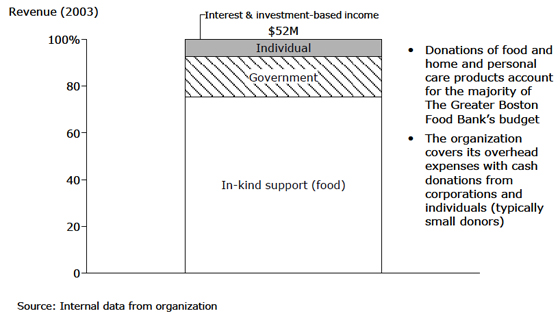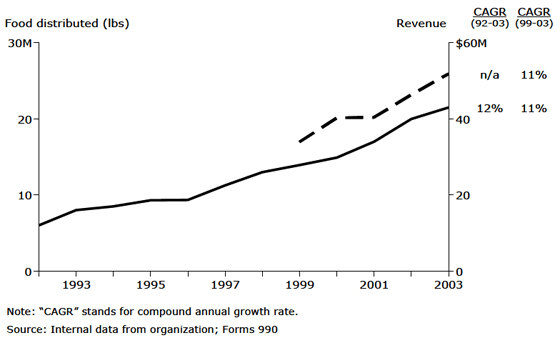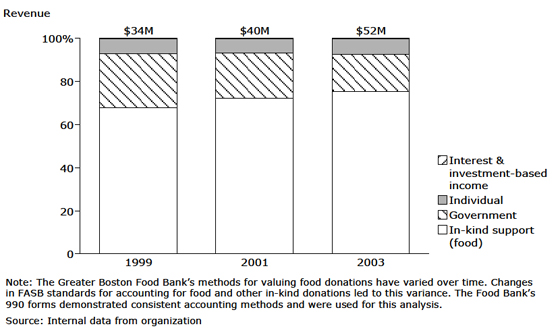We have taken the Food Bank from being a charity to a charitable business. It was the only way we could grow.
– Catherine D'Amato, President & Chief Executive Officer
Overview
Related Content
How Nonprofits Get Really BigOrganization Profiles from How Nonprofits Get Really Big
The Greater Boston Food Bank is the largest hunger-relief organization in New England, and one of the largest food banks in the country, distributing over 25 million pounds of food annually to hundreds of local agencies (e.g., local food pantries, soup kitchens, day-care centers, youth programs, senior centers, and homeless and residential shelters). Founded in 1981, The Food Bank is part of the America's Second Harvest™national network, the nation's largest hunger-relief organization. The Food Bank employs 65 people and uses the services of 14,000 volunteers annually to acquire, inspect, sort, warehouse, and distribute enormous quantities of food to agencies in nine counties and two islands in Massachusetts.
The Food Bank acquires food in many ways, with the dominant source being partnerships with retailers such as Stop & Shop Supermarket Company, Star Market Company, and Shaw's Supermarkets. It also receives surplus food from restaurants, caterers, hotels, corporate cafeterias, and universities through Second Helping, a perishable foods transfer program. Two commodity programs, The Massachusetts Emergency Food Assistance Program (MEFAP) and The Emergency Food Assistance Program (TEFAP) of the United States Department of Agriculture, are other major sources. The Food Bank uses financial donations, community food drives, and food donations from individuals and organizations to buy even more food
.
Founding date: 1981
Revenue (2004): $52 million
Structure: Single organization
NCCS classification: Food, agriculture, and nutrition—food banks and pantries
Services: Distributes food as well as home and personal care products to hundreds of local hunger-relief agencies in a dedicated partnership to feed the region's hungry
Beneficiaries:Under-nourished or hungry individuals
Leadership (selected): Catherine D'Amato, President & Chief Executive Officer; Carol Tienken, Chief Operating Officer; Kathleen Marre, Chief Financial Officer
Address: 99 Atkinson Street, Boston, MA 02118
Website: wwww.gbfb.org

Growth Story
- 1979 – A local homeless shelter creates the Boston Food Pantry.
- 1981 – The Boston Food Bank is incorporated and serves 60 agencies.
- 1982-1991 – The Food Bank steadily increases the amount of food it distributes. It grows to serve 700 agencies by adding transport and storage capacity and by developing new partnerships with food producers.
- 1993 - 1994 – The Food Bank serves over 800 agencies. It changes its name to the Greater Boston Food Bank, adds a development department, and initiates relationships with Boston-area foundations, city governments, and the state.
- 1995 – The Food Bank hires Catherine D’Amato as chief executive officer. It drafts a strategic plan focused on food acquisition, public image, education and customer service. A five-year transition period begins, during which the organization hires staff with relevant private sector expertise and implements new warehousing and distribution systems.
- 1997 - 1999 – The Food Bank reorganizes from seven departments to three. It hires a chief operating officer and continues to implement the strategic plan and to improve operational practices.
- 2002 - 2004 – The Food Bank appoints a chief financial officer, establishes marketing department and two distribution centers, and begins a capital campaign.
Revenue Trends
Revenue growth: The Food Bank’s growth has been fueled by more efficient and effective identification, processing, and distribution of products.

Funding mix: The Food Bank has complemented extensive food donations with government and individual support, to help fund the overhead necessary to sustain growth.

Actions That Helped Propel Growth in Funding
- Ran like a “charitable business.” Streamlining acquisitions, processing, and distribution and improving product safety and quality screens allowed the Food Bank to increase the food it distributed and the areas it served, which in turn provided a broader base for local fundraising. One approach which proved successful was researching and adopting best practices from for-profit companies. Engaging in strategic planning and developing annual workplans have also been key.
- Invested heavily in staff. The Food Bank’s chief financial officer actively pursued private sector hires with specific areas of expertise.
- Increased brand identity and recognition among local donors. Increasing volume of food it distributed and areas it served allowed the Food Bank to raise its profile in the Boston area. This visibility helped to attract new corporate and individual donors, whose unrestricted donations supported further central management growth.
- Diversified within a single type of support. The Food Bank consistently has sought new sources of donations as the food industry has evolved. Building staff expertise in specific segments of the food industry has helped.
Funding Challenges
- Responding to food industry distribution advances. As the food industry improves its distribution activities, inefficiencies the Food Bank once was able to exploit dry up. Accordingly, the organization continually must invest in developing new operational capabilities to address different food industry inefficiencies, such as those inherent with perishable foods.

